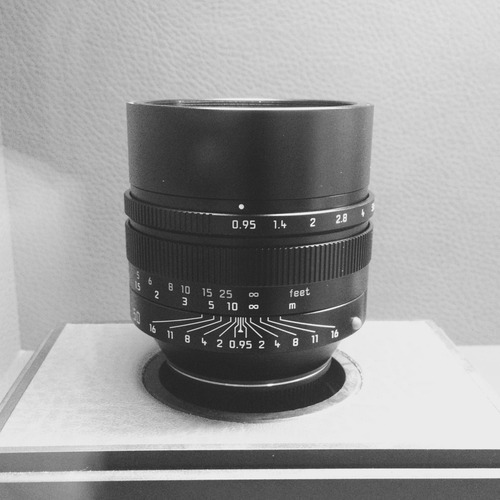It’s not often that the world’s largest Leica store (in terms of sq footage) opens up close to you, so last month, I dragged a couple of my coworkers/fellow enthusiasts to pay a visit.

As you can see from the photo of the Noctilux above, they had the full set of very expensive Leica gear, and they let us touch it!
Of particular interest to me were the new X Typ 113, and the Leica T.
I’ll start with the T. First impressions upon picking it up were that a) it’s heavy and b) it’s not as slippery as it looks. It looks nice in person, but to me it also somehow doesn’t look like a camera, and I can’t tell if that’s a good thing or not.
It had the 23mm mounted on it, so I walked around the store and took a few shots. AF wasn’t terrible, but definitely not fast. Images, as far as I could tell on the rear LCD (which is quite large) looked fine. Zooming in revealed the high quality of the prime lens.
After playing with it for a few minutes, navigating menus and the like, I got the distinct feeling that this is a v1 product (which it is). It makes some bold choices, some things work, but other things don’t. The thing that bothered me the most was the frame-rate of the UI. To review shots, you pull down from the top, but the animation that happens when you do that reminds you of 2010 android. Likewise for scrolling around the settings menu (which are visually very simple). It feels like they just put a really underpowered CPU in there to power the UI.
I found it somewhat ironic, since really if you think about it, Leica’s flagship M series is know for it’s feel. People choose the things because of the dials and precise manual focusing and the analog experience it gives you, despite the digital innards of the latest revisions. With the T, somehow it felt like this same attention to the feel of the camera didn’t extend into the firmware. The interface, while interesting and potentially even good, felt clunky because of it’s physics. If I’m going to spend two grand on a camera that is primarily operated through it’s touch screen, I expect to have a damn good touchscreen UI, and I don’t think the T’s UI lives up to that standard.
Maybe they’ll fix it in the T2. I do like the overall size and the possibility of being able to use real Leica lenses on an APS-C sized body, so I guess I’ll just have to stay tuned into what their doing.
On to the X. After playing with the T for a while, when I picked up the X, I almost threw it out of my hand. It is significantly lighter. It almost felt like a toy.
I immediately started checking out the behavior that Steve Huff talks about in his review. At close focusing distances, this camera stops down the lens to smaller apertures. At really close distances, it only opens up to f/2.8. I don’t know why but it just feels so misleading. There’s nothing I’ve seen in any of their marketing so far that has any indication of this behavior.
I didn’t get to play with the X as much, but the UI was much more traditional, much more straightforward camera. AF didn’t seem faster or slower than the T. Not terrible, but far from impressive.
After some time with both, strangely enough, I liked the X better. the T is interesting but needs some refinement. The X is much more traditional, and while it has that weird flaw, it’s still surprisingly light and probably takes some awesome images. Overall though, not sure that it’s worth anywhere close to the 2x price premium over, say, a Fuji X100S.